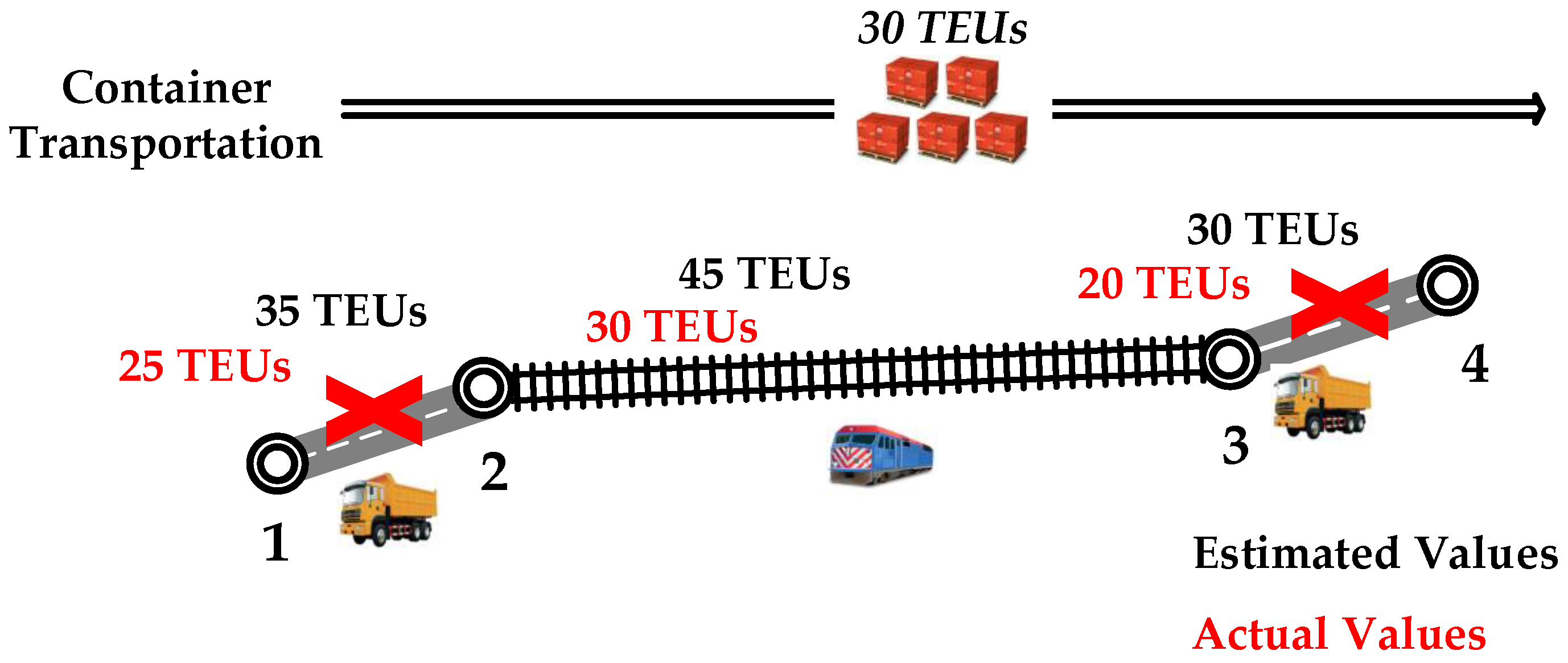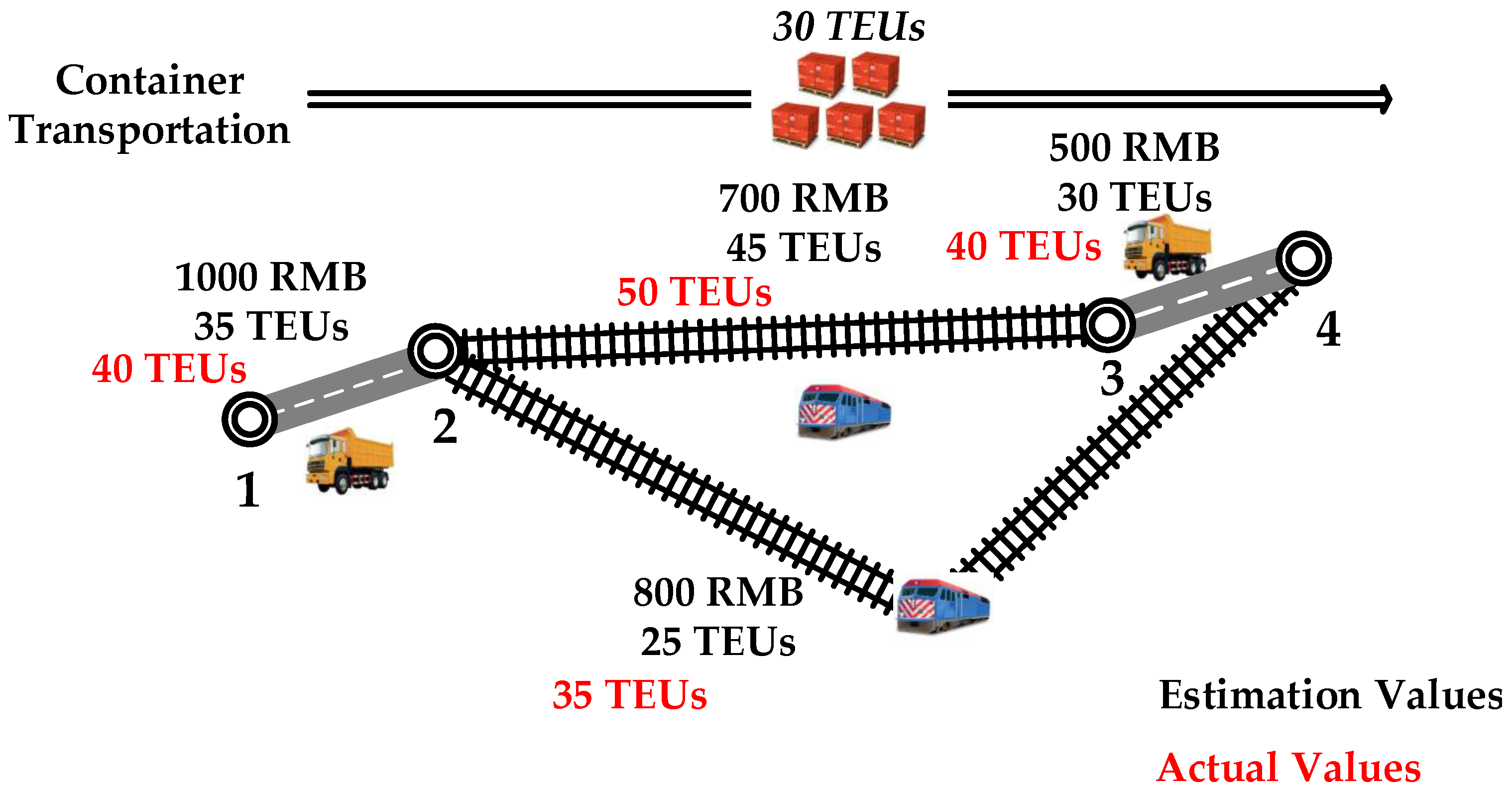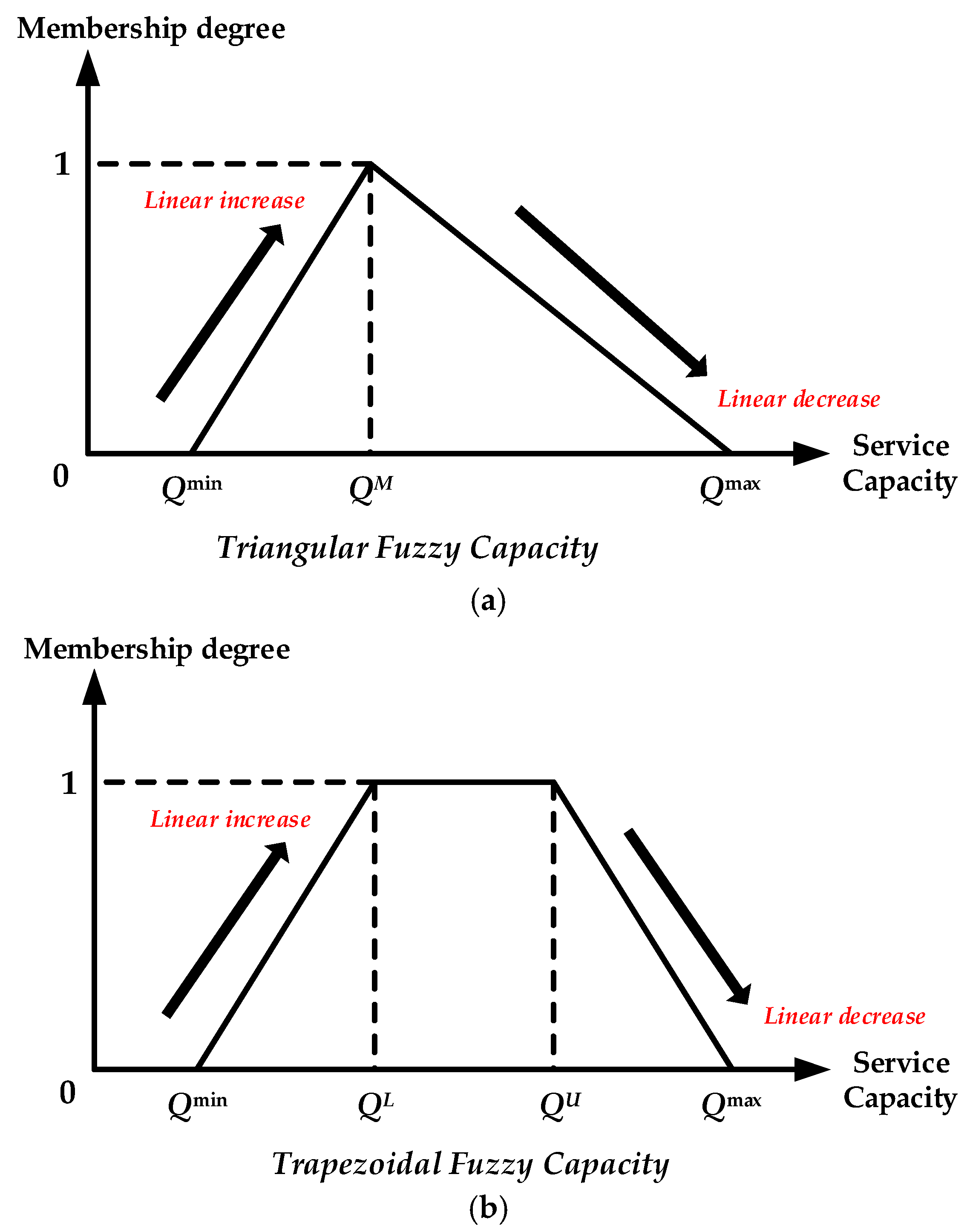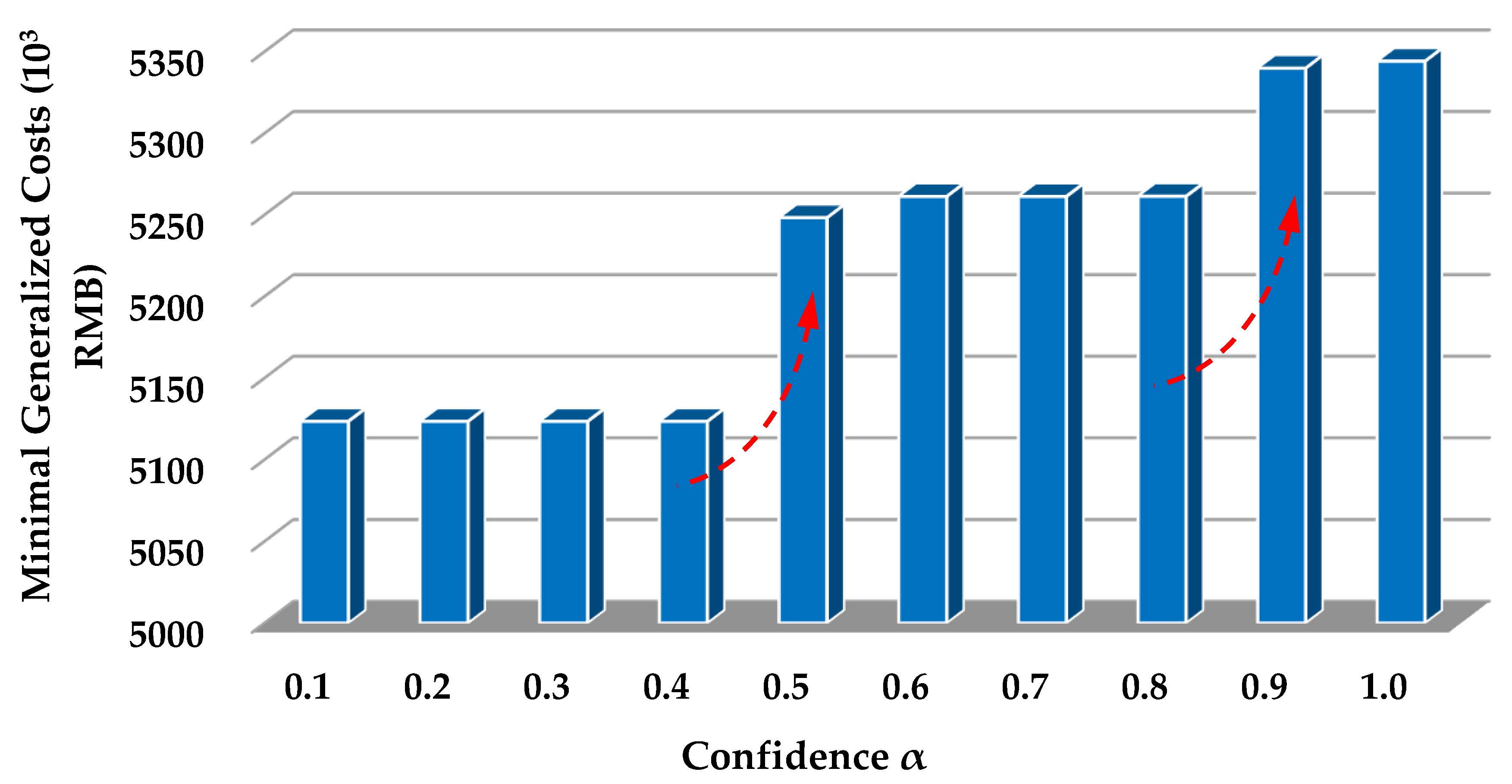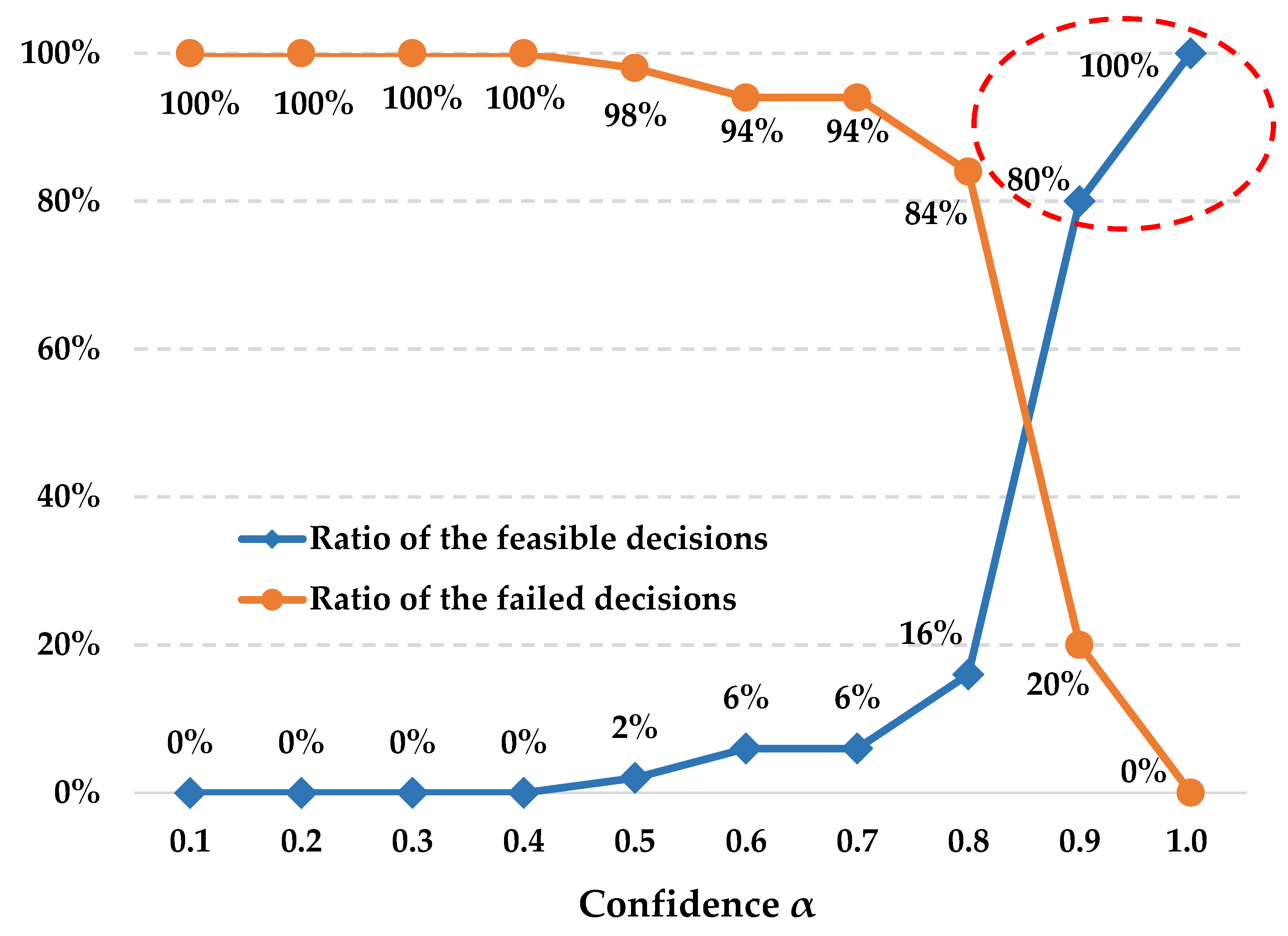1. Introduction
Intermodal transportation utilizes various transportation modes (e.g., railway, road, and waterway) to realize the transportation of containers. It has been widely acknowledged to be a better means of transportation compared with the unimodal transportation in many aspects (e.g., transportation economy and sustainability) [
1,
2], especially in the long-haul transportation setting. The intermodal routing decision aims at selecting the best routes to move containers from their origins to destinations through an intermodal service network to fulfill customers’ transportation demands. With the rapid development and promotion of intermodal transportation in international trade, the intermodal routing problem is now at the forefront of transportation planning [
3].
During the intermodal routing decision process, one of the challenges that decision makers need to deal with is how to consider the restriction of the service capacity on the intermodal route selection. In the existing literature, some studies do not consider the capacity constraint and formulated uncapacitated intermodal routing models to optimize their respective specific problems, e.g., Ziliaskopoulos and Wardell (2000) [
4], Lam and Srikanthan (2002) [
5], Boussedjra et al. (2004) [
6], Xiong and Wang (2014) [
7] and Sun and Chen (2013) [
8], etc. However, the uncapacitated scenario is impossible to be realized in transportation practice due to the following aspects.
- (1)
From the viewpoint of network topology, it is difficult (but not impossible) for transportation providers to assign adequate trucks and drivers to conduct all the road services on the arcs in the entire intermodal service network. Therefore, the road service capacity is limited.
- (2)
The capacity of a railway freight train is restricted by the limited power of the locomotive and the limited effective length of the railway tracks at the railway freight stations. Moreover, similar to road services, there are not infinite railway services on the network arcs. The railway service capacity is hence also limited.
Consequently, the intermodal routing decision based on the uncapacitated modeling is unreliable, because the actual existing capacities of the transportation services on the planned routes have considerable possibility of being violated, which will consequently result in failure. Therefore, the intermodal service network is capacitated. Thus the essence of the intermodal routing decision is the effective utilization of the limited resources of transportation services [
3]. The service capacity is an important issue that should not be neglected during the routing decision.
The majority of the current studies concentrated on the capacitated intermodal routing problem, e.g., Chang (2008) [
9], Sun et al. (2008) [
10], Kim et al. (2008) [
11], Ayar and Yaman (2012) [
12], Moccia et al. (2011) [
13], Lei et al. (2014) [
14], Sun and Lang (2015a, 2015b) [
15,
16] and Sun et al. (2016) [
17], etc. In the capacitated intermodal routing literature, deterministic numbers are used to express the service capacities. A capacity constraint is built to ensure that the total containers loaded on a certain service should not exceed its payload (e.g., the capacity of service 1 on arc 2 is 50 TEUs where TEU is the unit of ISO standard containers, which means that the total containers from different transportation orders assigned to service 1 on arc 2 should not exceed 50 TEUs). Compared with uncapacitated intermodal routing, the consideration of service capacity better matches the transportation practice and can greatly improve the feasibility of the intermodal routing decision.
It is widely known that the intermodal routing decision should be made before the actual transportation starts [
18]. During such a forward-looking decision process, decision makers cannot get exact information on all the transportation service capacities. First of all, the transportation services in the intermodal service network should also implement many other transportation tasks that fall out of the decision targets. Such tasks will occupy part of the capacities of the transportation services. However, predicting these tasks accurately is a heavy burden that is time-consuming and requires a lot of manpower. Consequently, it is infeasible to predict such transportation tasks and then deduct their occupied capacities from the total capacities. Secondly, there are many influencing factors that will also reduce the capacity utilization, e.g., vehicle faults, traffic accidents and bad weather. Therefore, it is difficult for decision makers to find a deterministic number to represent the capacity of a transportation service.
If decision makers insist on using deterministic numbers to represent the capacities of transportation services, two consequences will occur in the actual transportation if the containers are moved according to the intermodal routing decision with capacity certainty. The intermodal routing decision will be meaningless in this case.
- (1)
Optimistic estimation: the deterministic capacities evaluated by decision makers are larger than the actual available capacities of the services, which are known only when the transportation starts. In this case, the planned intermodal routes may be infeasible because it is possible that some transportation services cannot carry the number of containers assigned to them according to the routing decision. Taking
Figure 1 as an example, the estimated capacity values of the services on the road-railway-road intermodal route are 35 TEUs, 45 TEUs, and 30 TEUs (black). Based on these values, the route can move the containers with 30 TEUs from node 1 to node 4. However, since the estimation is optimistic, the actual values are smaller than the estimated ones. When the actual values are 25 TEUs, 30 TEUs and 20 TEUs (red), the route is infeasible because the road services on arc (1, 2) and arc (3, 4) cannot carry that number of containers. Thus, such route planning in the transportation practice failed. Consequently, under optimistic estimation, the planned route may be infeasible in practice.
- (2)
Pessimistic estimation: the deterministic capacities evaluated by the decision makers are smaller than the available capacities of the services. In this case, the planned intermodal routes will be certainly feasible but may be not the best ones. Taking
Figure 2 as an example, under pessimistic estimation, the best planned intermodal route is “(1) road service—(2) railway service—(3) road service—(4)”. The cost of the route is 2200 RMB. Since the estimation is pessimistic, the actual values are larger than the estimated ones. In this case, a railway service from node 2 to node 4 can be used to move the containers in practice. Thus, the actual best intermodal route would be “(1) road service—(2) railway service—(4)”. The cost of this route is 1800 RMB, which saves 400 RMB compared to the planned best route. Consequently, under a pessimistic estimation, the planned best route is feasible in practice but may not be the actual best scheme.
During the decision-making process, the situation will be more complicated due to the mixture of optimistic and pessimistic estimations of the service capacities. To avoid the consequences above, it is essential to fully consider the service capacity uncertainty in the intermodal routing decision to improve its reliability in supporting practical decision-making. However, according to the best of our knowledge, there are rare intermodal routing decision studies that systematically explore the influences of service capacity uncertainty on the intermodal routing decision, neither from a stochastic programming perspective nor a fuzzy programming perspective. Faced with such a research gap and in order to bridge it, this study mainly focuses on the following aspects:
- (1)
How do we model the service capacity uncertainty in a way that is easily realized in transportation practice?
- (2)
How do we analyze and summarize the influences of service capacity uncertainty on the intermodal routing decision?
In our previous study [
15], we presented a mixed-integer nonlinear programming (MINLP) model and developed a linearization-based exact solution strategy to solve the multicommodity intermodal routing problem with schedule-based railway services and time-flexible road services. This study was oriented on a consideration of deterministic service capacity, but still provided a solid foundation for us to discuss the issues of service capacity uncertainty. All the explorations regarding this study are on the basis of the transportation scenario, modeling framework, and solution strategy from our previous study.
The remainder of this study is organized as follows. In
Section 2, we formulate the service capacity uncertainty from the viewpoint of fuzziness and use trapezoidal fuzzy numbers to represent the uncertain service capacities. In
Section 3, we model the fuzzy chance constraint of the service capacity based on the credibility measure and generate crisp equivalent linear reformulations of the fuzzy chance constraint. Then we can use the proposed reformulations to replace the deterministic capacity constraint in the MILP model constructed in our previous study [
15] to create a linear programming model that focuses on the intermodal routing problem with service capacity uncertainty. In
Section 4, we present a case study to show how service capacity uncertainty influences the intermodal routing decision with the help of sensitivity analysis and fuzzy simulation. Finally, the conclusions of this study are drawn in
Section 5.
